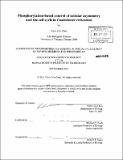| dc.contributor.advisor | Michael T. Laub. | en_US |
| dc.contributor.author | Chen, Yiyin Erin | en_US |
| dc.contributor.other | Massachusetts Institute of Technology. Dept. of Biology. | en_US |
| dc.date.accessioned | 2012-01-12T19:26:35Z | |
| dc.date.available | 2012-01-12T19:26:35Z | |
| dc.date.copyright | 2011 | en_US |
| dc.date.issued | 2011 | en_US |
| dc.identifier.uri | http://hdl.handle.net/1721.1/68425 | |
| dc.description | Thesis (Ph. D.)--Massachusetts Institute of Technology, Dept. of Biology, 2011. | en_US |
| dc.description | Cataloged from PDF version of thesis. | en_US |
| dc.description | Includes bibliographical references. | en_US |
| dc.description.abstract | Asymmetric cell division allows for better environmental adaptation and organismal complexity. Cells often divide by binary fission to form two identical daughter cells with similar developmental fates. However, a cell can also divide asymmetrically to form two daughter cells with different developmental fates. This process makes possible diverse behaviors such as differing life cycles respondent to environmental stimuli and specialization of cellular functions to generate organ systems. How cells divide asymmetrically and how they enforce the differential fates of daughter cells remain unsolved, fundamental problems in biology. In this work, I use the model organism Caulobacter crescentus to investigate how intracellular asymmetry within the mother cell is translated into the formation of two developmentally distinct daughter cells. Caulobacter is an alpha-proteobacterium that always divides asymmetrically to generate two daughter cells that are morphologically distinct and have different replicative capacities. I show that kinase and phosphatase activities at opposite poles of the cell generate a spatial gradient in the phosphorylation level of an essential cell cycle regulator called CtrA. This spatial gradient of CtrA phosphorylation enforces replicative asymmetry and couples it to the asymmetric morphogenesis of the daughter cells. I then investigate how CtrA's control of replicative asymmetry relates to the control of replication periodicity. I show that the activity of an essential replication initiator DnaA dictates the timing of replication initiation and oscillates independently of CtrA activity. The genetic separability of the spatial and temporal controls of replication in Caulobacter suggests that DnaA comprises an ancient and phylogenetically widespread control module for replication in almost all bacteria while CtrA developed later in c-proteobacteria and was recruited to enforce replicative asymmetry in daughter cells. This work provides a foundation for understanding cellular asymmetry and evolution of the cell cycle in bacteria. | en_US |
| dc.description.statementofresponsibility | by Yiyin Erin Chen. | en_US |
| dc.format.extent | 210 p. | en_US |
| dc.language.iso | eng | en_US |
| dc.publisher | Massachusetts Institute of Technology | en_US |
| dc.rights | M.I.T. theses are protected by
copyright. They may be viewed from this source for any purpose, but
reproduction or distribution in any format is prohibited without written
permission. See provided URL for inquiries about permission. | en_US |
| dc.rights.uri | http://dspace.mit.edu/handle/1721.1/7582 | en_US |
| dc.subject | Biology. | en_US |
| dc.title | Phosphorylation-based control of cellular asymmetry and the cell cycle in Caulobacter crescentus | en_US |
| dc.type | Thesis | en_US |
| dc.description.degree | Ph.D. | en_US |
| dc.contributor.department | Massachusetts Institute of Technology. Department of Biology | |
| dc.identifier.oclc | 768772324 | en_US |
